Abstract
Antibodies directed against thyroxine-binding globulin (TBG) have been used to screen a human liver lambda gt11 expression library. A 1.46-kilobase clone was identified which encodes nearly the complete amino acid sequence, beginning at amino acid 17 of the mature protein. To complete the protein sequence, the cDNA clone was used to identify a genomic clone coding for TBG in a human X chromosome library. The overlapping recombinant clones contained an open reading frame coding for 415 amino acids followed by a polyadenylylation signal (AATAAA) located 275 nucleotides from a TAG termination codon. Beginning at residue 21, the deduced amino acid sequence agrees closely with the known NH2-terminal sequence of the mature peptide. The preceding 20 amino acid residues are hydrophobic in character and presumably represent a leader sequence. Four glycosylation sites were identified, corresponding to the number determined for the purified protein. DNA blot hybridization revealed a single-copy gene, which by chromosomal analysis was found to be located on the long arm of the X chromosome. Unexpectedly, the nucleotide sequence of TBG is closely homologous to those encoding the plasma serine antiproteases alpha 1-antichymotrypsin and alpha 1-antitrypsin. However, there is little overall homology between TBG and transthyretin (prealbumin), the other major thyroxine-binding protein of human plasma.
Full text
PDF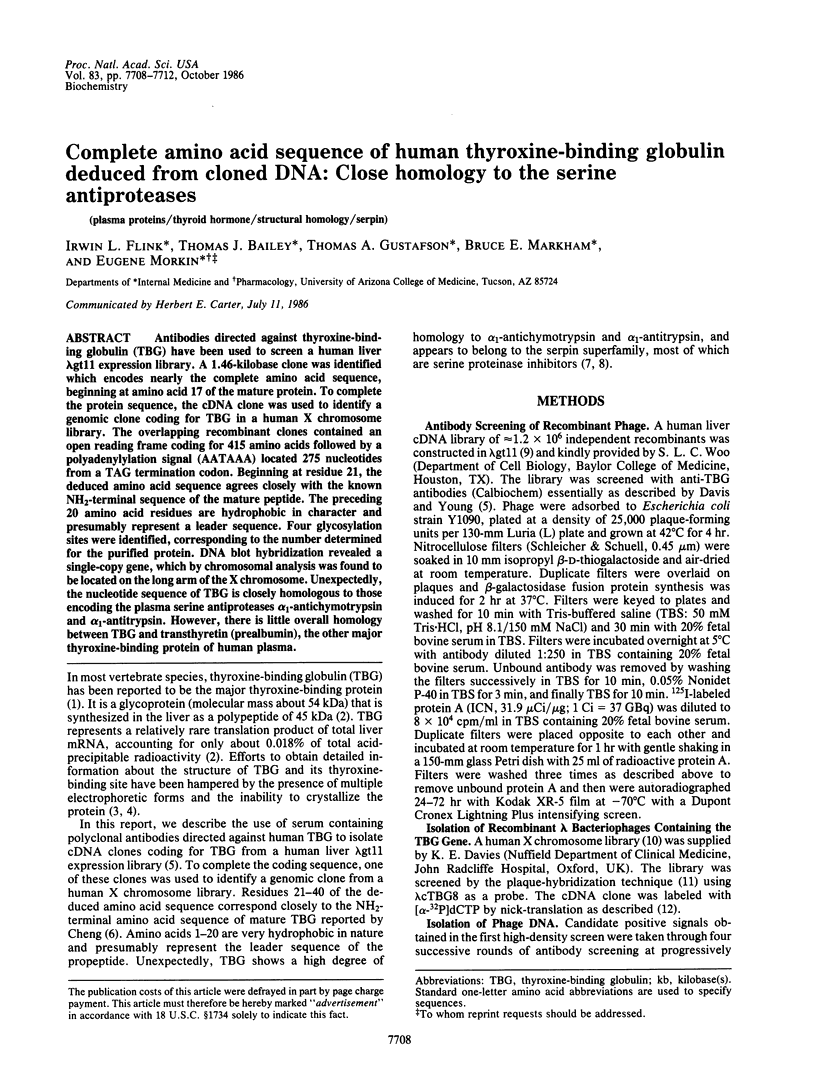
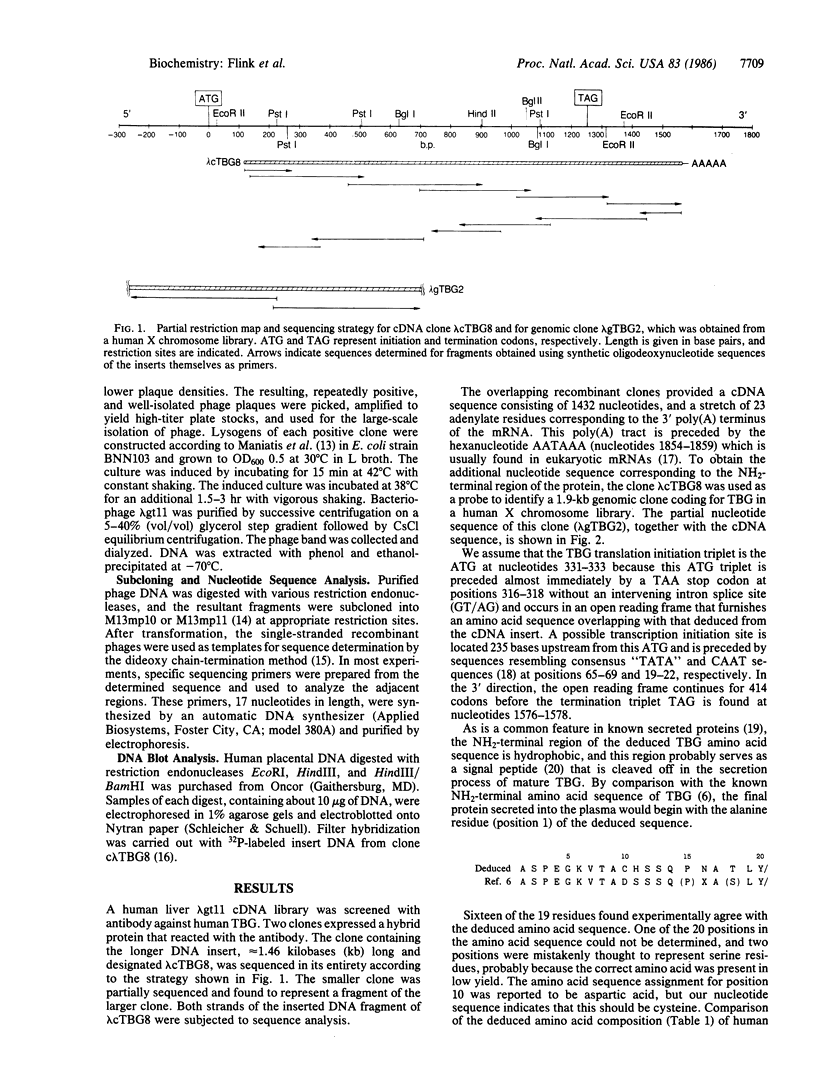
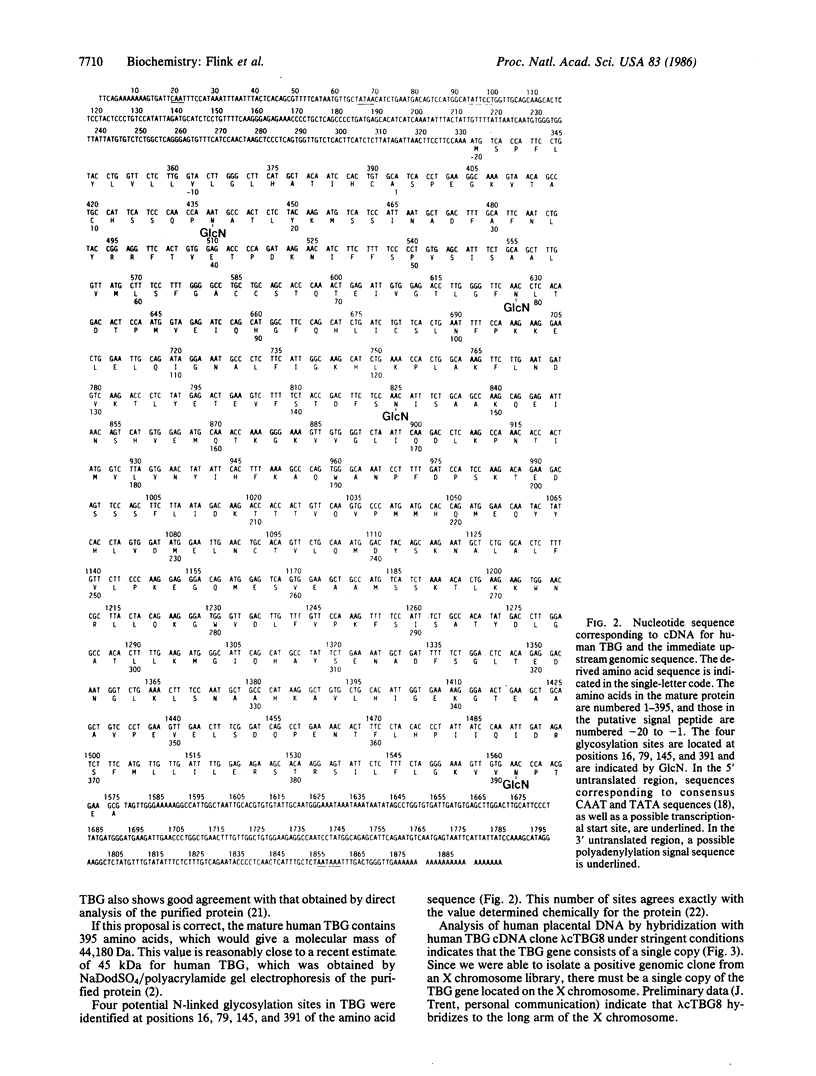
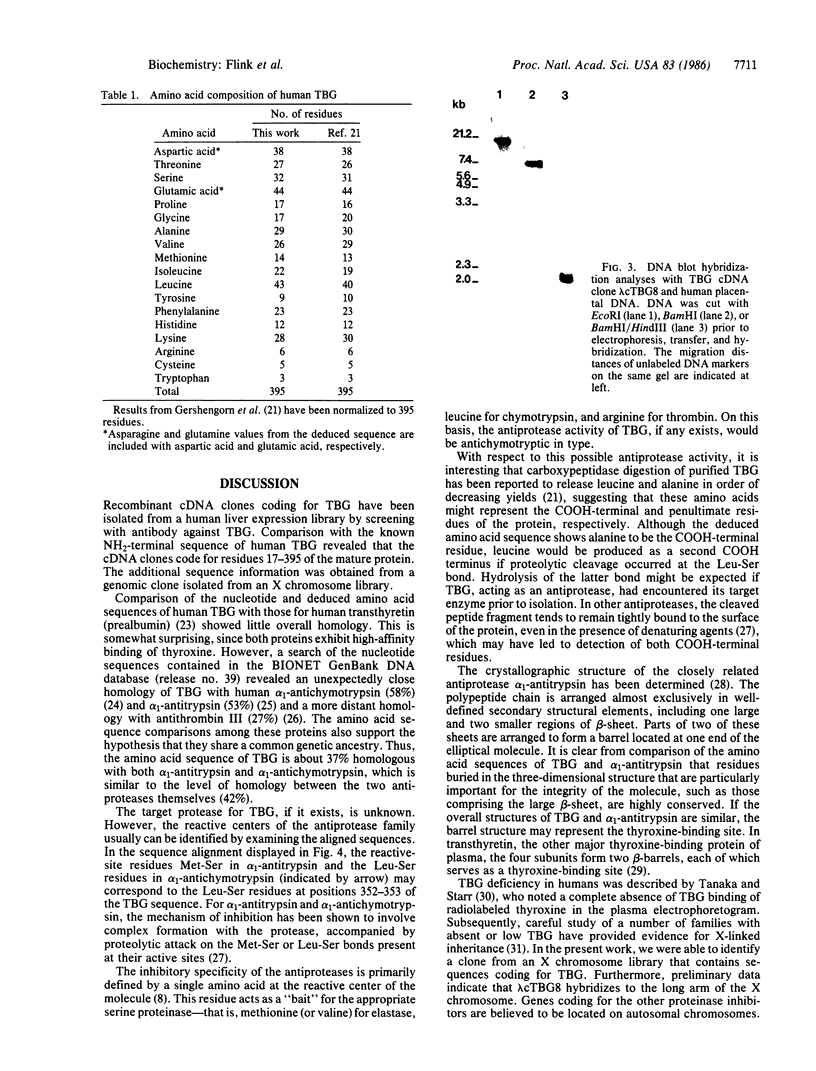
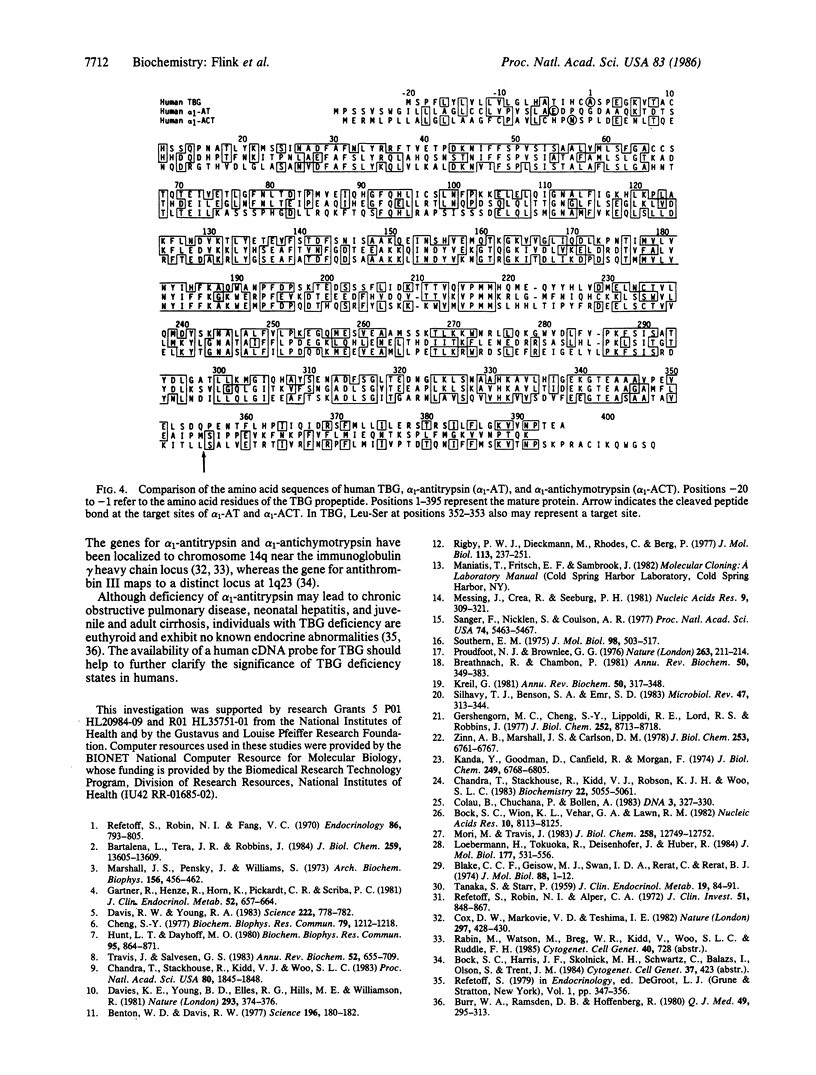
Images in this article
Selected References
These references are in PubMed. This may not be the complete list of references from this article.
- Bartalena L., Tata J. R., Robbins J. Characterization of nascent and secreted thyroxine-binding globulin in cultured human hepatoma (Hep G2) cells. J Biol Chem. 1984 Nov 10;259(21):13605–13609. [PubMed] [Google Scholar]
- Benton W. D., Davis R. W. Screening lambdagt recombinant clones by hybridization to single plaques in situ. Science. 1977 Apr 8;196(4286):180–182. doi: 10.1126/science.322279. [DOI] [PubMed] [Google Scholar]
- Blake C. C., Geisow M. J., Swan I. D., Rerat C., Rerat B. Strjcture of human plasma prealbumin at 2-5 A resolution. A preliminary report on the polypeptide chain conformation, quaternary structure and thyroxine binding. J Mol Biol. 1974 Sep 5;88(1):1–12. doi: 10.1016/0022-2836(74)90291-5. [DOI] [PubMed] [Google Scholar]
- Bock S. C., Wion K. L., Vehar G. A., Lawn R. M. Cloning and expression of the cDNA for human antithrombin III. Nucleic Acids Res. 1982 Dec 20;10(24):8113–8125. doi: 10.1093/nar/10.24.8113. [DOI] [PMC free article] [PubMed] [Google Scholar]
- Breathnach R., Chambon P. Organization and expression of eucaryotic split genes coding for proteins. Annu Rev Biochem. 1981;50:349–383. doi: 10.1146/annurev.bi.50.070181.002025. [DOI] [PubMed] [Google Scholar]
- Burr W. A., Ramsden D. B., Hoffenberg R. Hereditary abnormalities of thyroxine-binding globulin concentration. A study of 19 kindreds with inherited increase or decrease of thyroxine-binding globulin. Q J Med. 1980;49(195):295–313. [PubMed] [Google Scholar]
- Chandra T., Stackhouse R., Kidd V. J., Robson K. J., Woo S. L. Sequence homology between human alpha 1-antichymotrypsin, alpha 1-antitrypsin, and antithrombin III. Biochemistry. 1983 Oct 25;22(22):5055–5061. doi: 10.1021/bi00291a001. [DOI] [PubMed] [Google Scholar]
- Chandra T., Stackhouse R., Kidd V. J., Woo S. L. Isolation and sequence characterization of a cDNA clone of human antithrombin III. Proc Natl Acad Sci U S A. 1983 Apr;80(7):1845–1848. doi: 10.1073/pnas.80.7.1845. [DOI] [PMC free article] [PubMed] [Google Scholar]
- Cheng S. Y. Partial amino acid sequence of human thyroxine-binding globulin. Further evidence for a single polypeptide chain. Biochem Biophys Res Commun. 1977 Dec 21;79(4):1212–1218. doi: 10.1016/0006-291x(77)91135-4. [DOI] [PubMed] [Google Scholar]
- Colau B., Chuchana P., Bollen A. Revised sequence of full-length complementary DNA coding for human alpha 1-antitrypsin. DNA. 1984 Aug;3(4):327–330. doi: 10.1089/dna.1.1984.3.327. [DOI] [PubMed] [Google Scholar]
- Cox D. W., Markovic V. D., Teshima I. E. Genes for immunoglobulin heavy chains and for alpha 1-antitrypsin are localized to specific regions of chromosome 14q. Nature. 1982 Jun 3;297(5865):428–430. doi: 10.1038/297428a0. [DOI] [PubMed] [Google Scholar]
- Davies K. E., Young B. D., Elles R. G., Hill M. E., Williamson R. Cloning of a representative genomic library of the human X chromosome after sorting by flow cytometry. Nature. 1981 Oct 1;293(5831):374–376. doi: 10.1038/293374a0. [DOI] [PubMed] [Google Scholar]
- Gershengorn M. C., Cheng S. Y., Lippoldt R. E., Lord R. S., Robbins J. Characterization of human thyroxine-binding globulin. Evidence for a single polypeptide chain. J Biol Chem. 1977 Dec 10;252(23):8713–8718. [PubMed] [Google Scholar]
- Gärtner R., Henze R., Horn K., Pickardt C. R., Scriba P. C. Thyroxine-binding globulin: investigation of microheterogeneity. J Clin Endocrinol Metab. 1981 Apr;52(4):657–664. doi: 10.1210/jcem-52-4-657. [DOI] [PubMed] [Google Scholar]
- Hunt L. T., Dayhoff M. O. A surprising new protein superfamily containing ovalbumin, antithrombin-III, and alpha 1-proteinase inhibitor. Biochem Biophys Res Commun. 1980 Jul 31;95(2):864–871. doi: 10.1016/0006-291x(80)90867-0. [DOI] [PubMed] [Google Scholar]
- Kanda Y., Goodman D. S., Canfield R. E., Morgan F. J. The amino acid sequence of human plasma prealbumin. J Biol Chem. 1974 Nov 10;249(21):6796–6805. [PubMed] [Google Scholar]
- Kreil G. Transfer of proteins across membranes. Annu Rev Biochem. 1981;50:317–348. doi: 10.1146/annurev.bi.50.070181.001533. [DOI] [PubMed] [Google Scholar]
- Loebermann H., Tokuoka R., Deisenhofer J., Huber R. Human alpha 1-proteinase inhibitor. Crystal structure analysis of two crystal modifications, molecular model and preliminary analysis of the implications for function. J Mol Biol. 1984 Aug 15;177(3):531–557. [PubMed] [Google Scholar]
- Marshall J. S., Pensky J., Williams S. Studies on human thyroxine-binding globulin. 8. Isoelectric focusing evidence for microheterogeneity of thyroxine-binding globulin. Arch Biochem Biophys. 1973 Jun;156(2):456–462. doi: 10.1016/0003-9861(73)90294-4. [DOI] [PubMed] [Google Scholar]
- Messing J., Crea R., Seeburg P. H. A system for shotgun DNA sequencing. Nucleic Acids Res. 1981 Jan 24;9(2):309–321. doi: 10.1093/nar/9.2.309. [DOI] [PMC free article] [PubMed] [Google Scholar]
- Morii M., Travis J. Amino acid sequence at the reactive site of human alpha 1-antichymotrypsin. J Biol Chem. 1983 Nov 10;258(21):12749–12752. [PubMed] [Google Scholar]
- Proudfoot N. J., Brownlee G. G. 3' non-coding region sequences in eukaryotic messenger RNA. Nature. 1976 Sep 16;263(5574):211–214. doi: 10.1038/263211a0. [DOI] [PubMed] [Google Scholar]
- Refetoff S., Robin N. I., Alper C. A. Study of four new kindreds with inherited thyroxine-binding globulin abnormalities. Possible mutations of a single gene locus. J Clin Invest. 1972 Apr;51(4):848–867. doi: 10.1172/JCI106880. [DOI] [PMC free article] [PubMed] [Google Scholar]
- Refetoff S., Robin N. I., Fang V. S. Parameters of thyroid function in serum of 16 selected vertebrate species: a study of PBI, serum T4, free T4, and the pattern of T4 and T3 binding to serum proteins. Endocrinology. 1970 Apr;86(4):793–805. doi: 10.1210/endo-86-4-793. [DOI] [PubMed] [Google Scholar]
- Rigby P. W., Dieckmann M., Rhodes C., Berg P. Labeling deoxyribonucleic acid to high specific activity in vitro by nick translation with DNA polymerase I. J Mol Biol. 1977 Jun 15;113(1):237–251. doi: 10.1016/0022-2836(77)90052-3. [DOI] [PubMed] [Google Scholar]
- Sanger F., Nicklen S., Coulson A. R. DNA sequencing with chain-terminating inhibitors. Proc Natl Acad Sci U S A. 1977 Dec;74(12):5463–5467. doi: 10.1073/pnas.74.12.5463. [DOI] [PMC free article] [PubMed] [Google Scholar]
- Silhavy T. J., Benson S. A., Emr S. D. Mechanisms of protein localization. Microbiol Rev. 1983 Sep;47(3):313–344. doi: 10.1128/mr.47.3.313-344.1983. [DOI] [PMC free article] [PubMed] [Google Scholar]
- Southern E. M. Detection of specific sequences among DNA fragments separated by gel electrophoresis. J Mol Biol. 1975 Nov 5;98(3):503–517. doi: 10.1016/s0022-2836(75)80083-0. [DOI] [PubMed] [Google Scholar]
- TANAKA S., STARR P. Clinical observations on serum globulin thyroxine-binding capacity, using a simplified technique. J Clin Endocrinol Metab. 1959 Jan;19(1):84–91. doi: 10.1210/jcem-19-1-84. [DOI] [PubMed] [Google Scholar]
- Travis J., Salvesen G. S. Human plasma proteinase inhibitors. Annu Rev Biochem. 1983;52:655–709. doi: 10.1146/annurev.bi.52.070183.003255. [DOI] [PubMed] [Google Scholar]
- Young R. A., Davis R. W. Yeast RNA polymerase II genes: isolation with antibody probes. Science. 1983 Nov 18;222(4625):778–782. doi: 10.1126/science.6356359. [DOI] [PubMed] [Google Scholar]
- Zinn A. B., Marshall J. S., Carlson D. M. Preparation of glycopeptides and oligosaccharides from thyroxine-binding globulin. J Biol Chem. 1978 Oct 10;253(19):6761–6767. [PubMed] [Google Scholar]





